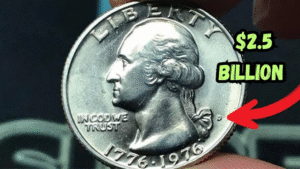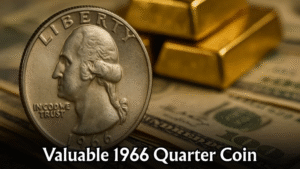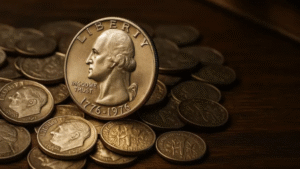$2.5 Billion Bicentennial Quarter: Imagine pulling a quarter from your wallet that’s worth $2.5 billion! The 1976 Bicentennial Quarter, minted to celebrate America’s 200th birthday, has sparked excitement with rumors of a rare version valued at this incredible amount. While most of these quarters are worth just 25 cents, a unique one could still be hiding in your change. This guide explains what makes this coin so special, how to spot it, and why collectors are buzzing. Start checking your quarters—you might have a treasure!
What is the 1976 Bicentennial Quarter?
The Bicentennial Quarter is a 25-cent coin made by the U.S. Mint in 1975 and 1976 to mark 200 years of American independence. It features George Washington’s face on the front, designed by John Flanagan, and a colonial drummer with “1776-1976” on the back, created by Jack L. Ahr. Over 1.6 billion were produced in Philadelphia (no mint mark), Denver (“D”), and San Francisco (“S”). Most are common, but rare ones with errors or special traits could be worth millions—or even billions.
Why is This Quarter Worth $2.5 Billion?
The $2.5 billion price tag is speculative, with no confirmed sale at this level, but experts believe a one-of-a-kind version could fetch a fortune due to key factors.
Unique Minting Errors
This quarter might have been struck on the wrong metal, like a 90% silver planchet instead of copper-nickel, or show errors like doubled lettering or off-center designs. These mistakes make it extremely rare.
Special Materials
Some think it’s a test coin or prototype made with unique metals, like high-purity silver or gold, meant for experiments but accidentally released.
Perfect Condition
Coins graded MS-68 or higher by PCGS or NGC, with no wear and sharp details, are worth far more. A flawless Bicentennial Quarter could command top prices.
Huge Collector Demand
Tied to America’s bicentennial celebration, this coin’s rumored rarity drives intense interest, potentially pushing its value to astronomical levels at auctions.
How to Spot a $2.5 Billion Bicentennial Quarter
Could you have one? Here’s how to check your quarters:
- Date: Look for “1776-1976” on the front, marking it as a Bicentennial Quarter.
- Mint Mark: Check below Washington’s neck for “D” (Denver), “S” (San Francisco), or no mark (Philadelphia). Rare ones may have an “S” or no mark.
- Material: Regular quarters weigh 5.67 grams and have a copper stripe on the edge. Silver ones weigh about 6.25 grams with a solid silver edge.
- Errors: Use a magnifying glass to spot doubled text, misaligned designs, or a shiny, proof-like finish.
- Sound Test: Tap gently. Silver coins make a sharp ring; copper-nickel ones sound duller.
Never clean a coin—it lowers its value! If you suspect a rare one, take it to a professional grader like PCGS or NGC for verification.
Value of Rare Bicentennial Quarters
Here’s a table of estimated values for key Bicentennial Quarter varieties based on recent sales:
| Variety | Description | Estimated Value (Circulated) | Estimated Value (Uncirculated) |
|---|---|---|---|
| 1976 Silver Error | Struck on 90% silver planchet | $50–$500 | $1,000–$100,000+ |
| 1976 Doubled Die | Doubled date or lettering | $20–$100 | $200–$8,400 |
| 1976-S Silver Proof | 40% silver, San Francisco | $5–$10 | $50–$19,200 |
| 1976 Off-Center Strike | Misaligned design | $10–$50 | $100–$2,800 |
Note: Prices vary with market trends and grading. Data from Heritage Auctions and PCGS. The $2.5 billion valuation is unverified but reflects hype for a unique error or prototype coin.
Tips for Finding and Selling Your Quarter
Bicentennial Quarters are still legal tender, so they could be in your change, coin rolls, or old jars. Check these spots:
- Loose change from stores or vending machines
- Family coin collections or piggy banks
- Bank coin rolls or estate sales
If you find a promising quarter, handle it by the edges and store it in a soft plastic holder to avoid scratches. Get it authenticated by a grading service to confirm its value. Selling options include trusted coin dealers, auction houses like Heritage Auctions, or platforms like eBay. Be cautious of fakes—counterfeiters target high-value rumors, so always verify with experts.
Conclusion
The $2.5 billion Bicentennial Quarter may sound like a myth, but its possibility has ignited a treasure hunt across the country. With rare errors, unique materials, and a tie to America’s 200th birthday, this coin could be hiding in your pocket. Even if you don’t find the fabled billion-dollar quarter, other rare versions are worth thousands. Grab a magnifying glass and start checking your quarters today—you might uncover a piece of history worth a fortune!
FAQ
How can I tell if my Bicentennial Quarter is worth $2.5 billion?
Check for “1776-1976,” a silver edge (weighing ~6.25 grams), or errors like doubled text or off-center designs. Get it graded by PCGS or NGC.
Are all Bicentennial Quarters valuable?
Most are worth 25 cents unless they have rare errors, like a silver planchet, or are in perfect condition.
Has a Bicentennial Quarter sold for $2.5 billion?
No, this is a speculative estimate. The highest confirmed sale is $19,200 for a 1976-S Silver Proof.
Where can I sell a rare Bicentennial Quarter?
Sell through trusted coin dealers, auction houses like Heritage Auctions, or eBay after professional grading.
Can I still find one in circulation?
Yes, it’s rare but possible in change, coin rolls, or old collections since they’re still legal tender.



